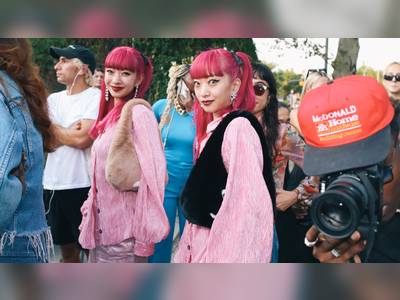These gems include Rajo Laurel and Ivar Aseron, who were invited to showcase their collections at the Bali Fashion Week held last Nov. 22-25 at Discovery Kartika Plaza Hotel in Kuta Beach. Laurel and Aseron, the first Filipino designers to participate in the event’s seven-year history, were featured prominently in the shows.
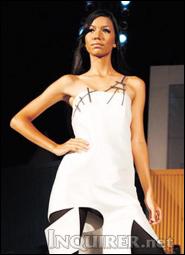
WHITE cutout dress by Aseron. Photo by Bianca Consunji
“Rajo and Ivar were highly recommended by people who were familiar with Philippine fashion,” said Ika Mardiana, an Indonesian designer and chair of Bali Fashion Week. “We have had many international designers showcase their collections in the past, and we’re honored to have the Philippines’ best for this year’s shows.”
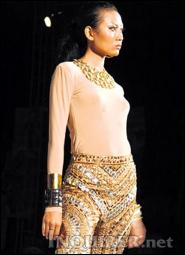
INDIGENOUS designs by Laurel. Photo by Bianca Consunji
The theme for the 2007 Bali Fashion Week was “Fashion Meets Art.” This was something that the organizers strove to highlight in every aspect of the event (although it was often distracting, as traditional cultural presentations were alternated with models walking down the runway).
“We want to blend tourism, trade and investment,” Mardiana said. “Bali has a remarkable legacy of a unique culture, and we want to maximize that asset.”
She continued, “We represent a lot of ethnic fashion. The rich colors that Indonesia is famous for is reflected in both our designs and models, and we want people to draw inspiration from that. That is why we invited our Asian neighbors and Western friends to participate in the show.”
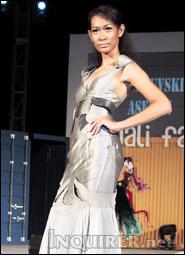
GUNMETAL gray gown by Aseron. Photo by Bianca Consunji
Safe and conventional
Such loyalty to the culture was apparent in the runway shows and trade fair, as many designers proudly used indigenous materials and designs for their gowns and RTW collections. However, this sometimes worked against them, as the collections featured on the first night of Fashion Week tended to be safe and conventional instead of innovative.
Traditional Balinese garb from Indonesian designers and companies such as Parang Kencana, Allure Batik, Afif Syakur, Ida Munthe, Musa, Yenli and Zaenal Songket ruled the runway on the first night. Although the intentions of the designers were admirable, their fanaticism for all things Indonesian tended to alienate the foreign audience. After several of these collections, people were already chatting with each other instead of watching the show.
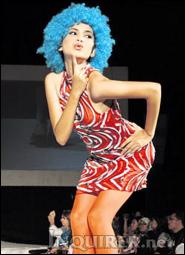
MARDIANA’S wigs and platforms make a statement. Photo by Bianca Consunji
The second night showed a marked improvement from the first, as it showcased a more varied selection of clothes from Indonesian and international designers. Dresses, gowns, children’s clothes and quirky costumes were presented in a more tongue-in-cheek manner: models danced down the runway, and for one particularly interesting collection, fire breathers and a giant robot accompanied a nightclub-theme set.
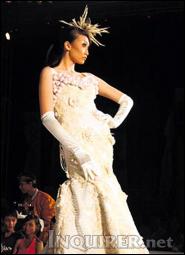
BEADS, brocade, sequins and balls in a bridal gown by Ira Damayanti. Photo by Bianca Consunji
Major highlight
One of the major highlights of the second night, however, was Aseron’s collection. Inspired by chiaroscuro (the interplay of light and shadow), the collection featured dresses and gowns in shades of black, white and gray.
The clothes once again displayed Aseron’s ability to produce tailored clothes without compromising femininity. Indonesian fashion commentators praised Aseron for his clean lines and well-structured forms, calling his designs “revolutionary and avant garde.”
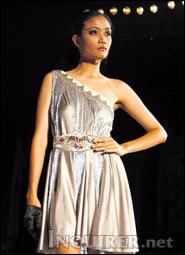
GRECIAN-INSPIRED sheath by Selphie Bong. Photo by Bianca Consunji
In contrast to Aseron’s subdued gowns was Mardiana’s colorful collection of clothes. Her dresses, inspired by ’60s mod, featured juicy colors and wild prints paired with stockings, wigs, and platform shoes.
Mardiana also produced a set of flag-themed dresses, inspired by flags from Indonesia, Switzerland, the United States, the United Kingdom, Australia and the Philippines, among others.
Aside from Mardiana, other international designers such as the Australia-based Lily Jean (whose white eyelet and black lace dresses wowed the audience) took center stage.
Indigenous materials
The undeniable star of the entire fashion week, however, was Rajo Laurel, whose Igorot-theme collection was featured in the finale of the final day of the event. The predominantly gold collection, which used indigenous Filipino materials such as sinamay cloth and capiz shells, was praised by the Indonesian press as “elaborate and luxurious.”
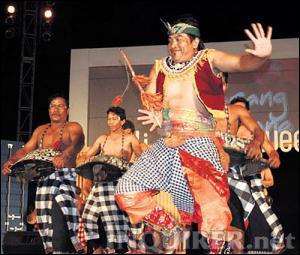
CULTURAL presentations were interspersed with the fashion shows. Photo by Bianca Consunji
What could otherwise be considered a fault in the Bali Fashion Week (such as the strong emphasis on Balinese design and use of local models, who were admittedly not as tall and thin as those usually used in other Fashion Weeks) could also be considered their strength.
While most Asian countries place heavy emphasis on Western influence, the Bali Fashion Week organizers and designers stuck to their roots, almost as if to say, “This is who we are. Take it or leave it.”
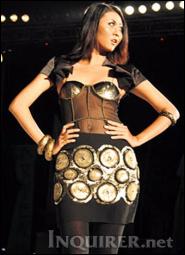
GOLD-TRIMMED evening wear by Selphie Bong. Photo by Bianca Consunji
Many local designers could learn a thing or two from such nationalism, but for designers such as Aseron and Laurel, who managed to combine just the right touch of international influence and local design, making it big in the international scene shouldn’t be a problem.

